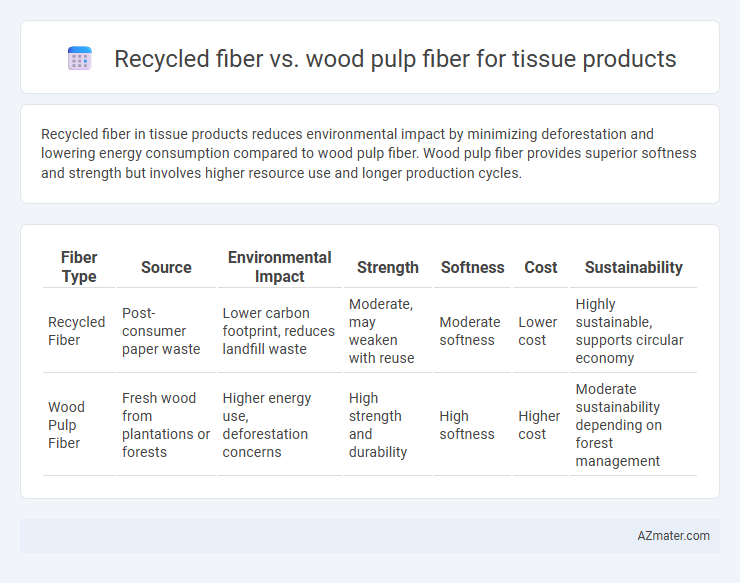Recycled fiber in tissue products reduces environmental impact by minimizing deforestation and lowering energy consumption compared to wood pulp fiber. Wood pulp fiber provides superior softness and strength but involves higher resource use and longer production cycles.
Table of Comparison
| Fiber Type | Source | Environmental Impact | Strength | Softness | Cost | Sustainability |
|---|---|---|---|---|---|---|
| Recycled Fiber | Post-consumer paper waste | Lower carbon footprint, reduces landfill waste | Moderate, may weaken with reuse | Moderate softness | Lower cost | Highly sustainable, supports circular economy |
| Wood Pulp Fiber | Fresh wood from plantations or forests | Higher energy use, deforestation concerns | High strength and durability | High softness | Higher cost | Moderate sustainability depending on forest management |
Introduction to Tissue Product Fibers
Tissue products commonly utilize two primary fiber sources: recycled fiber and wood pulp fiber, each influencing product quality and environmental impact. Wood pulp fiber, derived from virgin timber, offers longer fibers that enhance strength and softness in tissue products. Recycled fiber, sourced from post-consumer paper waste, provides sustainability benefits but may introduce shorter fibers and impurities affecting tissue durability and texture.
Overview of Recycled Fiber
Recycled fiber in tissue products is derived primarily from post-consumer paper waste, which undergoes deinking and cleaning processes to remove contaminants. This fiber offers environmental benefits by reducing deforestation, lowering water consumption, and minimizing energy use compared to virgin wood pulp fiber. Despite a slightly lower fiber strength and softness, advances in fiber processing technologies have improved the quality and performance of recycled fiber in tissue manufacturing.
Overview of Wood Pulp Fiber
Wood pulp fiber, primarily derived from softwood and hardwood trees, offers superior strength and softness essential for high-quality tissue products. Its natural long fibers contribute to enhanced absorbency and durability, making it the preferred choice for premium tissues. Despite higher production costs and environmental concerns, wood pulp fiber maintains a significant presence in tissue manufacturing due to its performance advantages.
Environmental Impact Comparison
Recycled fiber in tissue products significantly reduces deforestation by utilizing post-consumer waste, lowering the demand for virgin wood pulp and conserving natural forests. The manufacturing process of recycled fiber consumes less water and energy, resulting in a smaller carbon footprint compared to wood pulp fiber production. However, recycled fibers may involve chemical treatments to remove contaminants, which can impact water quality but overall maintain a lower environmental burden than wood pulp sourcing.
Performance and Quality Differences
Recycled fiber in tissue products often contains shorter fibers and higher impurity levels, resulting in lower tensile strength and reduced softness compared to wood pulp fiber. Wood pulp fiber provides superior absorbency, bulk, and durability due to its longer, stronger fibers, making it preferred for premium tissue products. Performance in softness, strength, and absorbency significantly favors wood pulp fiber, while recycled fiber emphasizes sustainability with some compromise in quality.
Cost and Economic Considerations
Recycled fiber for tissue products generally offers lower raw material costs due to the use of recovered paper, reducing reliance on virgin wood pulp, which is more expensive and subject to market fluctuations. However, processing recycled fiber can incur higher energy and chemical costs to remove contaminants, impacting overall production expenses. Balancing these factors, manufacturers often find that incorporating recycled fiber can lead to cost savings while supporting sustainable practices, though final economics depend on local recycling infrastructure and supply chain efficiency.
Consumer Perception and Market Trends
Recycled fiber in tissue products appeals to environmentally conscious consumers seeking sustainability and reduced ecological impact, driving demand for eco-friendly options in the market. Wood pulp fiber remains favored for its softness and strength, maintaining a loyal segment of consumers prioritizing quality and comfort in tissue products. Market trends indicate a growing preference for recycled fibers, supported by increasing regulations and retailer commitments to sustainable sourcing, while product innovation aims to balance performance with environmental benefits.
Manufacturing Challenges and Solutions
Recycled fiber in tissue manufacturing presents challenges such as higher levels of contaminants, variability in fiber quality, and reduced softness compared to wood pulp fiber, which is naturally cleaner and more consistent in strength. To overcome these issues, advanced cleaning technologies, improved deinking processes, and refined fiber blending techniques are employed to enhance the quality and uniformity of recycled fiber pulp. Optimizing manufacturing parameters like refining intensity and chemical additives ensures that recycled fiber tissue products meet consumer expectations for softness and durability.
Regulatory Standards and Certifications
Recycled fiber for tissue products must comply with strict regulations such as the FDA's 21 CFR Part 176 for indirect food contact materials and the European Union's EN 13432 standard for compostability. Wood pulp fiber is often certified under standards like FSC (Forest Stewardship Council) and PEFC (Programme for the Endorsement of Forest Certification), ensuring sustainable forestry practices and traceability. Both fiber types require adherence to safety and environmental certifications such as ISO 14001 for environmental management systems to meet industry and consumer demands.
Future Outlook for Fiber Choices in Tissue Products
Recycled fiber is expected to gain prominence in tissue products due to increasing sustainability demands and regulatory push for reduced environmental impact in manufacturing. Wood pulp fiber, valued for its softness and strength, will continue to be essential but may be supplemented by advanced fiber blends to balance performance with ecological benefits. Innovations in fiber processing and circular economy initiatives will drive a diversified fiber portfolio, optimizing cost, quality, and sustainability in future tissue product development.

Infographic: Recycled fiber vs Wood pulp fiber for Tissue product
 azmater.com
azmater.com